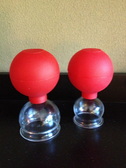Cupping

Like moxibustion, cupping is one of the oldest methods of treatment in Chinese medicine. The process usually involves glass jars, although bamboo and pottery cups may still be used in places. The cups are positioned on the skin, usually at acupuncture points or along meridian channels. They adhere to the skin by virtue of suction, either by creating a vacuum inside the cup with a flame, or by squeezing the air out through pumping. The pump methodology generally gives the practitioner more control over the desired level of suction and reduces the risk of burning injuries. When the suction is created, the skin is drawn slightly into the cup. This drawing up of skin opens the pores and stimulates the flow of blood and Qi. Cupping therefore relieves stagnation, similarly to gua sha.
Cupping may be done by either leaving them in one place or slowly sliding them along a trajectory over lubricated skin. Typically, stationary cups are retained for approximately five to ten minutes. The methodology is best suited for fleshier areas of the body, especially the back, hips or abdomen. Because the blood is drawn to the skin, cupping usually leaves round reddish marks. These are not usually uncomfortable and fade within a few days.
Cupping may be done by either leaving them in one place or slowly sliding them along a trajectory over lubricated skin. Typically, stationary cups are retained for approximately five to ten minutes. The methodology is best suited for fleshier areas of the body, especially the back, hips or abdomen. Because the blood is drawn to the skin, cupping usually leaves round reddish marks. These are not usually uncomfortable and fade within a few days.
Indications for Using Cupping
Much like gua sha, cupping is used to relieve pain where there is stagnation of blood and Qi. Cupping is also widely used to treat digestive irregularities and respiratory disorders like asthma, bronchitis and other lung congestion. Cupping helps the body regulate temperature influences, drawing out excess heat and helping to expel cold. This aspect is what makes it effective in treating the respiratory and digestive complaints that are a result of the "climatic factors" of heat or cold.
Kay's Personal Cupping Story
"Many years ago my young daughter had a bad night with the swine flu. In Chinese medicine, the flu is considered a wind heat invasion. As her fever spiked and she labored to breathe, I quickly applied gua sha to her back and placed two cups over her "lung correspondence points." The skin under the cups immediately turned scarlet red (an indication of heat release) and within a minute or two she began breathing normally. I did too! I called off the trip to the emergency room and we both went back to sleep. Over night she broke her fever and felt perfectly fine the next day."